Judd–Ofelt Analysis and Spectroscopy Study of Tellurite Glasses Doped with Rare-Earth (Nd3+, Sm3+, Dy3+, and Er3+)
Abstract
:1. Introduction
2. Materials and Methods
2.1. Glass Synthesis
2.2. Characterization
3. Results and Discussion
3.1. X-ray Diffraction Analysis
3.2. Thermal Properties
3.3. Physical, Optical Properties
3.4. Judd–Ofelt Analysis
3.5. Spectra of Absorption and Judd–Ofelt Analysis
3.5.1. Neodymium (Nd3+)
3.5.2. Samarium (Sm3+)
3.5.3. Dysprosium (Dy3+)
3.5.4. Erbium (Er3+)
3.6. Raman Spectra
4. Conclusions
Author Contributions
Funding
Data Availability Statement
Acknowledgments
Conflicts of Interest
References
- Selvi, S.; Marimuthu, K.; Muralidharan, G. Structural and luminescence behavior of Sm3+ ions doped lead boro-telluro-phosphate glasses. J. Lumin. 2015, 159, 207–218. [Google Scholar] [CrossRef]
- Elkhoshkhany, N.; Marzouk, S.; El-Sherbiny, M.; Ibrahim, H.; Burtan-Gwizdala, B.; Alqahtani, M.S.; Hussien, K.I.; Reben, M.; Yousef, E.S. Investigation of structural, physical, and attenuation parameters of glass: TeO2-Bi2O3-B2O3-TiO2-RE2O3 (RE: La, Ce, Sm, Er, and Yb), and applications thereof. Materials 2022, 15, 5393. [Google Scholar] [CrossRef]
- Yousef, E.; Hegazy, H.; Elokr, M.; Aboudeif, Y. Raman spectroscopy and raman gain coefficient of telluroniobium-zinc-lead oxyglasses doped with rare earth. Chalcogenide Lett. 2015, 12, 653–663. [Google Scholar]
- Stalin, S.; Gaikwad, D.; Samee, M.; Edukondalu, A.; Ahmmad, S.K.; Joshi, A.; Syed, R. Structural, optical features and gamma ray shielding properties of Bi2O3– TeO2– B2O3-GeO2 glass system. Ceram. Int. 2020, 46, 17325–17334. [Google Scholar] [CrossRef]
- Fong, W.; Baki, S.O.; Arifin, N.; Mansor, Y.; Nazri, A.; Abbas, B.K. Structural, thermal and optical properties of rare earth doped lead-tellurite oxide glasses. J. Adv. Res. Fluid Mech. Therm. Sci. 2021, 81, 52–58. [Google Scholar]
- Layne, C.; Lowdermilk, W.; Weber, M.J. Multiphonon relaxation of rare-earth ions in oxide glasses. Phys. Rev. B 1977, 16, 10. [Google Scholar] [CrossRef]
- Serqueira, E.; Dantas, N.; Monte, A.; Bell, M. Judd Ofelt calculation of quantum efficiencies and branching ratios of Nd3+ doped glasses. J. Non-Cryst. Solids 2006, 352, 3628–3632. [Google Scholar] [CrossRef]
- Lalla, E.; Konstantinidis, M.; De Souza, I.; Daly, M.; Martín, I.; Lavín, V.; Rodríguez-Mendoza, U. Judd-Ofelt parameters of RE3+-doped fluorotellurite glass (RE3+ = Pr3+, Nd3+, Sm3+, Tb3+, Dy3+, Ho3+, Er3+, and Tm3+). J. Alloys Compd. 2020, 845, 156028. [Google Scholar] [CrossRef]
- Baki, S.; Tan, L.; Kan, C.; Kamari, H.; Noor, A.; Mahdi, M. Structural and optical properties of Er3+-Yb3+ codoped multicomposition TeO2-ZnO-PbO-TiO2-Na2O glass. J. Non-Cryst. Solids 2013, 362, 156–161. [Google Scholar] [CrossRef]
- Damak, K.; Maâlej, R.; Qusti, A.H.; Rüssel, C. Thermal and spectroscopic properties of Tm3+ doped TZPPN transparent glass laser material. J. Non-Cryst. Solids 2012, 358, 2974–2980. [Google Scholar] [CrossRef]
- Damak, K.; Charfi, B.; Algarni, H.; Alqahtani, M.S.; Alshari, A.; Reben, M.; Abd-Rabboh, H.S. Characterization of oxyfluoride glasses doped with rare-earth ions through structural, thermal, and optical application thereof. Results Phys. 2022, 34, 105255. [Google Scholar]
- Dousti, M.; Amjad, R.; Sahar, M.; Zabidi, Z.; Alias, A.; de Camargo, A.S.S. Er3+-doped zinc tellurite glasses revisited: Concentration dependent chemical durability, thermal stability and spectroscopic properties. J. Non-Cryst. Solids 2015, 429, 70–78. [Google Scholar] [CrossRef]
- Saad, M.; Poulain, M. Glass forming ability criterion. In Materials Science Forum; Trans Tech Publications Ltd.: Bach, Switzerland, 1987; pp. 11–18. [Google Scholar]
- Iezid, M.; Goumeidane, F.; Abidi, A.; Poulain, M.; Legouera, M.; Prasad, P.S.; Środa, M.; Rao, P.V. Judd-Ofelt analysis and luminescence studies of Er3+ doped halogeno-antimonate glasses. Opt. Mater. 2021, 120, 111422. [Google Scholar] [CrossRef]
- Suthanthirakumar, P.; Arunkumar, S.; Marimuthu, K. Spectroscopic properties and excited state dynamics of Sm3+ ions in zinc telluro-fluoroborate glasses. J. Lumin. 2018, 202, 289–300. [Google Scholar] [CrossRef]
- Elkhoshkhany, N.; Marzouk, S.; El–Sherbiny, M.; Yousri, S.; Alqahtani, M.S.; Algarni, H.; Reben, M. Enhanced thermal stability and optical and structural properties of Tm3+ ions in doped tellurite glasses for photonic use. Results Phys. 2021, 24, 104202. [Google Scholar] [CrossRef]
- Dimitrov, V.; Sakka, S. Linear and nonlinear optical properties of simple oxides. II. J. Appl. Phys. 1996, 79, 1741–1745. [Google Scholar] [CrossRef]
- Van Deun, R.; Binnemans, K.; Görller-Walrand, C.; Adam, J.-L. Judd–Ofelt intensity parameters of trivalent lanthanide ions in a NaPO3–BaF2 based fluorophosphate glass. J. Alloys Compd. 1999, 283, 59–65. [Google Scholar] [CrossRef]
- Wu, J. Thulium Doped Microsphere Laser and Fiber Laser; The University of Arizona: Tucson, AZ, USA, 2005. [Google Scholar]
- Azlan, M.; Halimah, M. Role of Nd3+ nanoparticles on enhanced optical efficiency in borotellurite glass for optical fiber. Results Phys. 2018, 11, 58–64. [Google Scholar] [CrossRef]
- Klimesz, B.; Dominiak-Dzik, G.; Żelechower, M.; Ryba-Romanowski, W. Optical study of GeO2–PbO–PbF2 oxyfluoride glass single doped with lanthanide ions. Opt. Mater. 2008, 30, 1587–1594. [Google Scholar] [CrossRef]
- Nieboer, E.; Jørgensen, C.; Peacock, R.; Reisfeld, R.; Peacock, R.D. The intensities of lanthanide f↔ f transitions. In Rare Earths; Springer: Berlin/Heidelberg, Germany, 1975; pp. 83–122. [Google Scholar]
- Rao, V.H.; Prasad, P.S.; Babu, M.M.; Rao, P.V.; Santos, L.F.; Raju, G.N.; Veeraiah, N. Luminescence properties of Sm3+ ions doped heavy metal oxide tellurite-tungstate-antimonate glasses. Ceram. Int. 2017, 43, 16467–16473. [Google Scholar] [CrossRef]
- Amjad, R.J.; Sahar, M.; Ghoshal, S.; Dousti, M.; Arifin, R. Synthesis and characterization of Dy3+ doped zinc–lead-phosphate glass. Opt. Mater. 2013, 35, 1103–1108. [Google Scholar] [CrossRef]
- Kumar, V.R.K.; Bhatnagar, A.K.; Jagannathan, R. Structural and optical studies of Pr3+, Nd3+, Er3+ and Eu3+ ions in tellurite based oxyfluoride, TeO2-LiF, glass. J. Phys. D Appl. Phys. 2001, 34, 1563. [Google Scholar] [CrossRef]
- Yuliantini, L.; Djamal, M.; Hidayat, R.; Boonin, K.; Kaewkhao, J.; Yasaka, P. Luminescence and Judd-Ofelt analysis of Nd3+ ion doped oxyfluoride boro-tellurite glass for near-infrared laser application. Mater. Today Proc. 2021, 43, 2655–2662. [Google Scholar] [CrossRef]
- Costa, F.; Yukimitu, K.; Nunes, L.; Figueiredo, M.; Andrade, L.; Lima, S.; Moraes, J. Spectroscopic properties of Nd3+-doped tungsten–tellurite glasses. J. Phys. Chem. Solids 2016, 88, 54–59. [Google Scholar] [CrossRef]
- Mahraz, Z.A.S.; Sazali, E.; Sahar, M.; Amran, N.U.; Yaacob, S.; Aziz, S.M.; Mawlud, S.; Noor, F.; Harun, A. Spectroscopic investigations of near-infrared emission from Nd3+-doped zinc-phosphate glasses: Judd-Ofelt evaluation. J. Non-Cryst. Solids 2019, 509, 106–114. [Google Scholar] [CrossRef]
- Thomas, S.; Rasool, S.N.; Rathaiah, M.; Venkatramu, V.; Joseph, C.; Unnikrishnan, N. Spectroscopic and dielectric studies of Sm3+ ions in lithium zinc borate glasses. J. Non-Cryst. Solids 2013, 376, 106–116. [Google Scholar] [CrossRef]
- Thomas, S.; George, R.; Rasool, S.N.; Rathaiah, M.; Venkatramu, V.; Joseph, C.; Unnikrishnan, N. Optical properties of Sm3+ ions in zinc potassium fluorophosphate glasses. Opt. Mater. 2013, 36, 242–250. [Google Scholar] [CrossRef]
- Rayappan, I.A.; Selvaraju, K.; Marimuthu, K. Structural and luminescence investigations on Sm3+ doped sodium fluoroborate glasses containing alkali/alkaline earth metal oxides. Phys. B Condens. Matter 2011, 406, 548–555. [Google Scholar] [CrossRef]
- Jamalaiah, B.; Kumar, J.S.; Babu, A.M.; Suhasini, T.; Moorthy, L.R. Photoluminescence properties of Sm3+ in LBTAF glasses. J. Lumin. 2009, 129, 363–369. [Google Scholar] [CrossRef]
- Rajesh, D.; Ratnakaram, Y.; Seshadri, M.; Balakrishna, A.; Krishna, T.S. Structural and luminescence properties of Dy3+ ion in strontium lithium bismuth borate glasses. J. Lumin. 2012, 132, 841–849. [Google Scholar] [CrossRef]
- Pisarska, J. Optical properties of lead borate glasses containing Dy3+ ions. J. Phys. Condens. Matter 2009, 21, 285101. [Google Scholar] [CrossRef] [PubMed]
- Elkhoshkhany, N.; Marzouk, S.; El–Sherbiny, M.; Anwer, H.; Alqahtani, M.S.; Algarni, H.; Reben, M. Investigation of structural and luminescence properties of borosilicate glass doped with Dy2O3. Results Phys. 2021, 27, 104544. [Google Scholar] [CrossRef]
- Mahraz, Z.A.S.; Sahar, M.; Ghoshal, S.; Dousti, M.R. Concentration dependent luminescence quenching of Er3+-doped zinc boro-tellurite glass. J. Lumin. 2013, 144, 139–145. [Google Scholar] [CrossRef]
- Rodin, N.L.A.; Sahar, M. Erbium doped sodium magnesium boro-tellurite glass: Stability and Judd-Ofelt analysis. Mater. Chem. Phys. 2018, 216, 177–185. [Google Scholar] [CrossRef]
- Fang, R.; Mei, Y.-Z.; Chao, G.; Zhu, L.-G.; Lu, A.-X. Thermal stability and Judd-Ofelt analysis of optical properties of Er3+-doped tellurite glasses. Trans. Nonferrous Met. Soc. China 2012, 22, 2021–2026. [Google Scholar]
- Sajna, M.; Thomas, S.; Mary, K.A.; Joseph, C.; Biju, P.; Unnikrishnan, N. Spectroscopic properties of Er3+ ions in multicomponent tellurite glasses. J. Lumin. 2015, 159, 55–65. [Google Scholar] [CrossRef]
- Wang, G.; Zhang, J.; Dai, S.; Wen, L.; Yang, J.; Jiang, Z. Structural investigation on TeO2–BiCl3 glassy system. J. Mol. Struct. 2005, 750, 1–6. [Google Scholar] [CrossRef]
- Ozdanova, J.; Ticha, H.; Tichy, L. Remark on the optical gap in ZnO–Bi2O3–TeO2 glasses. J. Non-Cryst. Solids 2007, 353, 2799–2802. [Google Scholar] [CrossRef]
- Fares, H.; Jlassi, I.; Elhouichet, H.; Férid, M. Investigations of thermal, structural and optical properties of tellurite glass with WO3 adding. J. Non-Cryst. Solids 2014, 396, 1–7. [Google Scholar] [CrossRef]
- Jlassi, I.; Elhouichet, H.; Hraiech, S.; Ferid, M. Effect of heat treatment on the structural and optical properties of tellurite glasses doped erbium. J. Lumin. 2012, 132, 832–840. [Google Scholar] [CrossRef]
- Jyothi, L.; Upender, G.; Kuladeep, R.; Rao, D.N. Structural, thermal, optical properties and simulation of white light of titanium-tungstate-tellurite glasses doped with dysprosium. Mater. Res. Bull. 2014, 50, 424–431. [Google Scholar] [CrossRef]
- Elkholy, H.; Othman, H.; Hager, I.; Ibrahim, M.; de Ligny, D. Thermal and optical properties of binary magnesium tellurite glasses and their link to the glass structure. J. Alloys Compd. 2020, 823, 153781. [Google Scholar] [CrossRef]
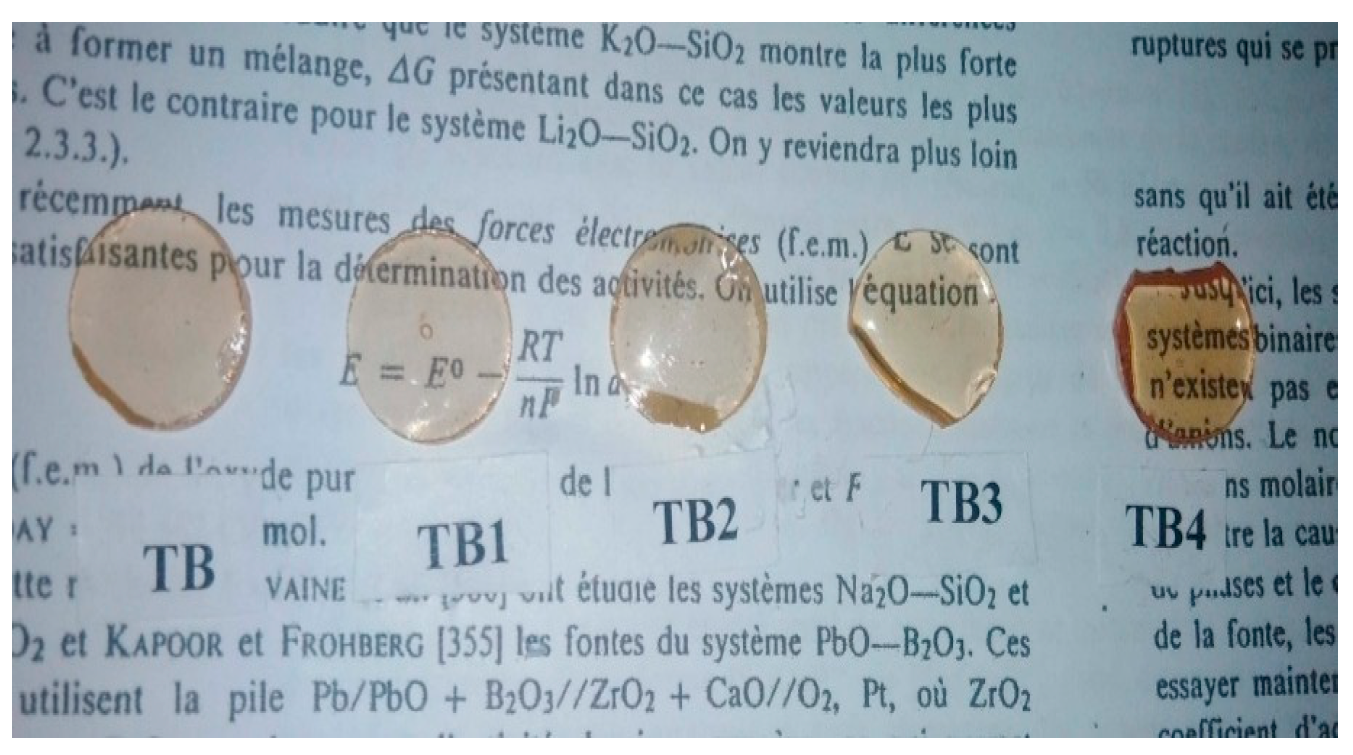
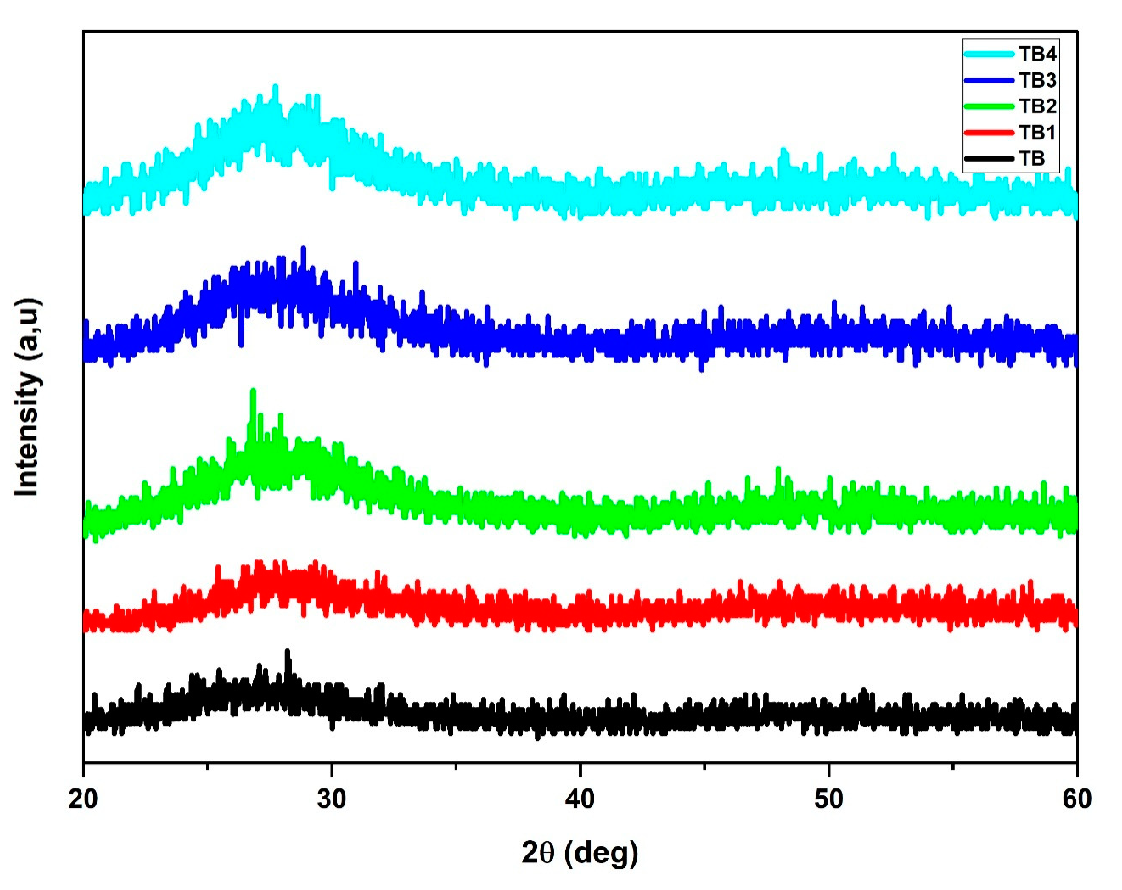
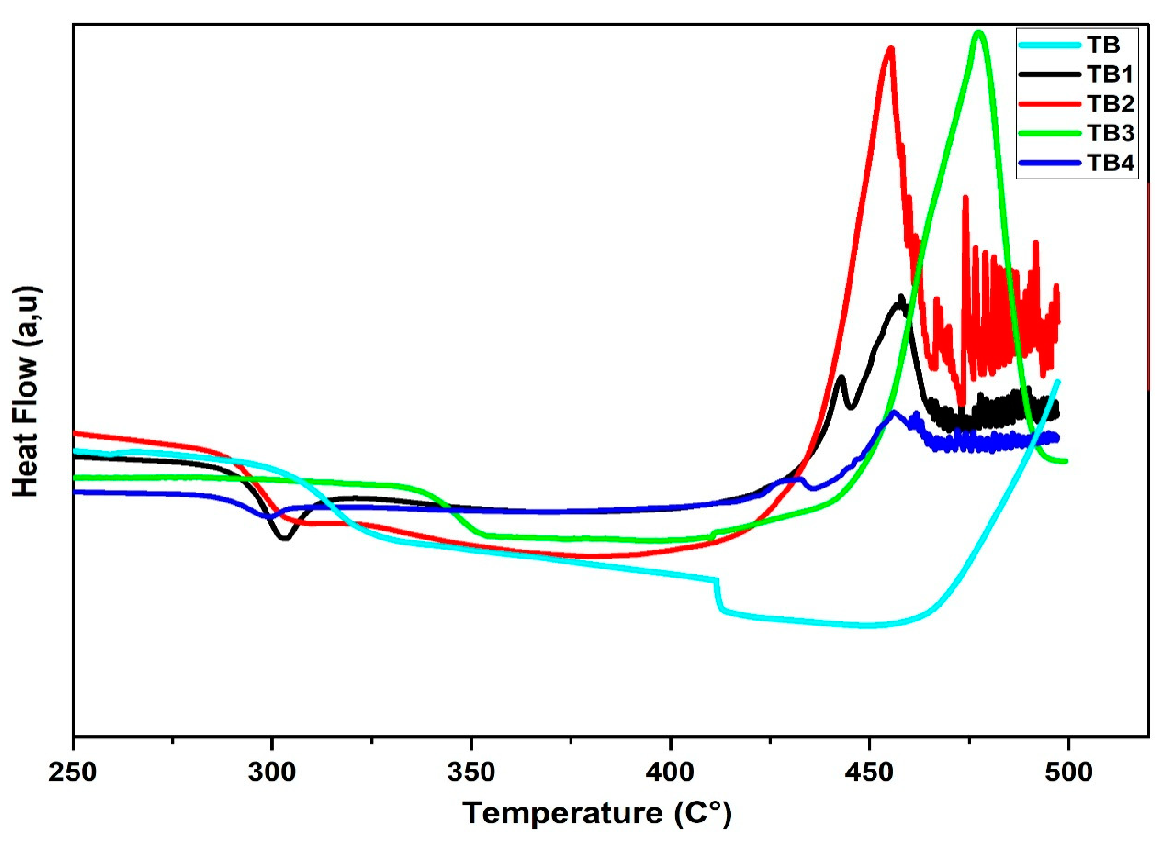
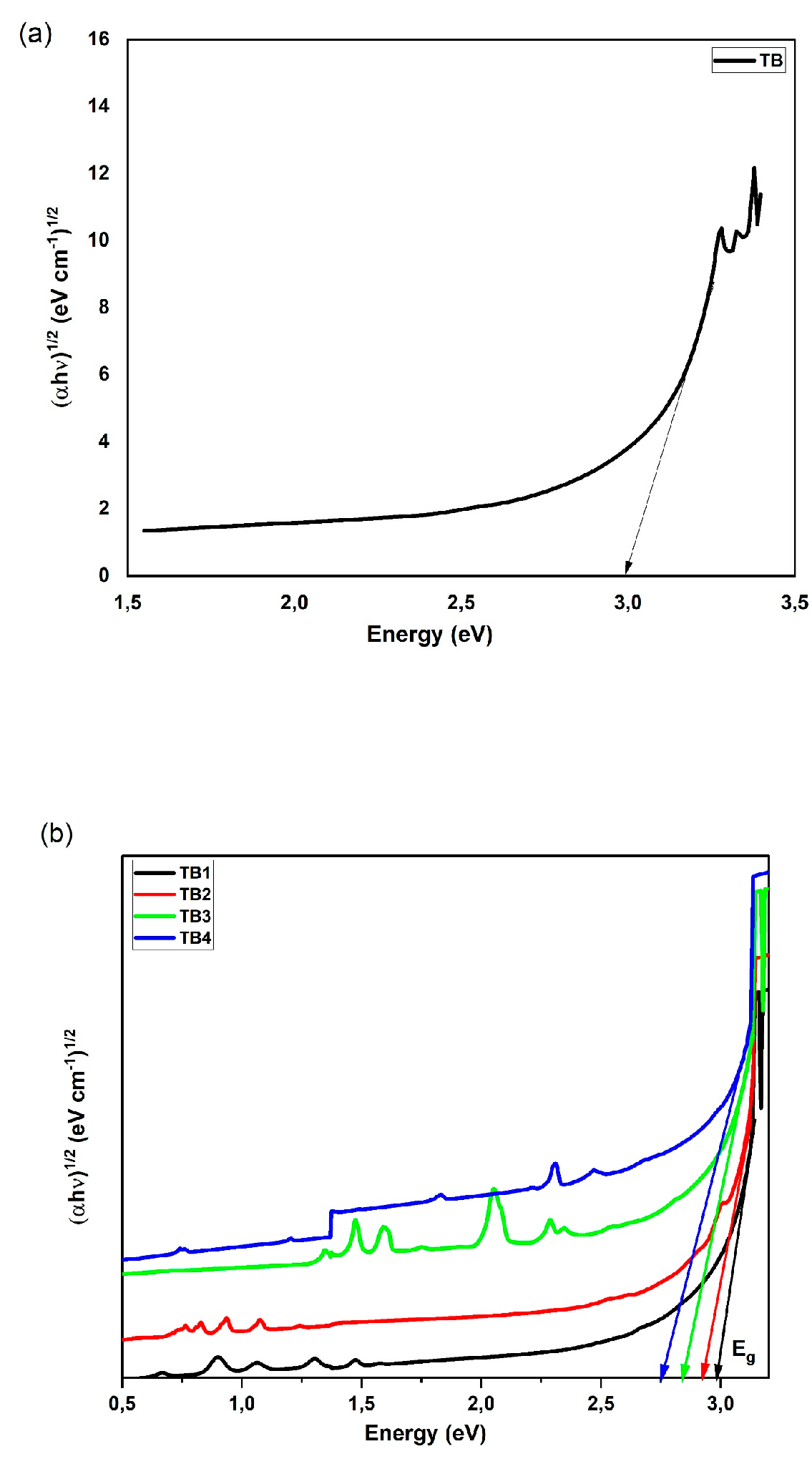
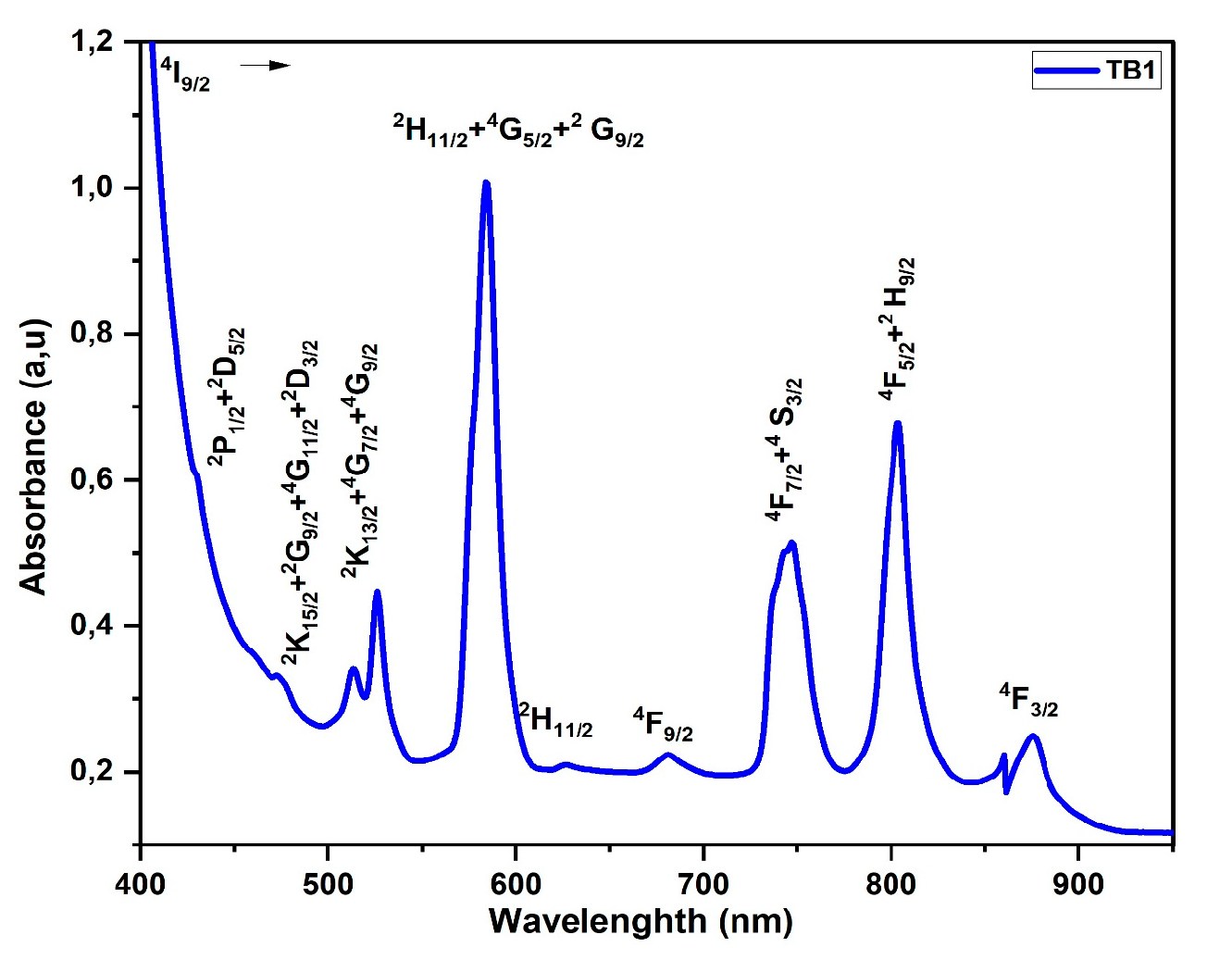
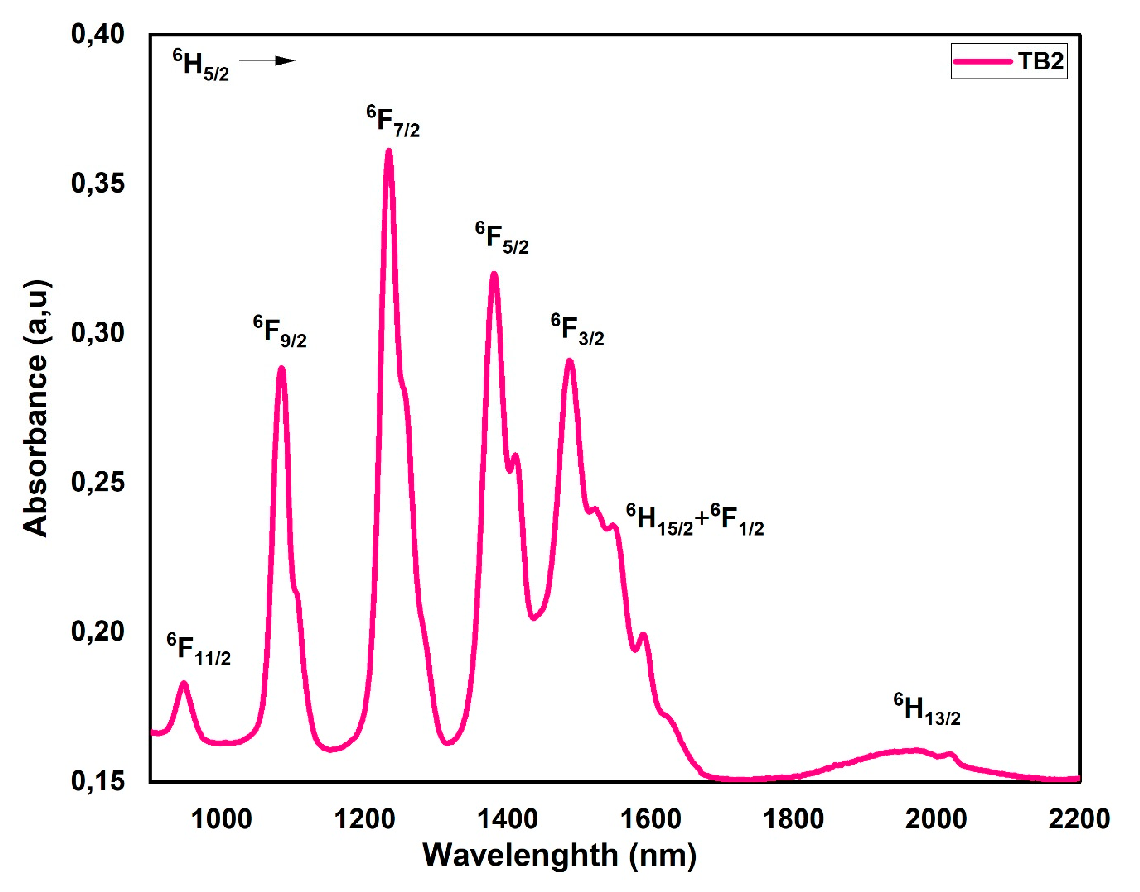

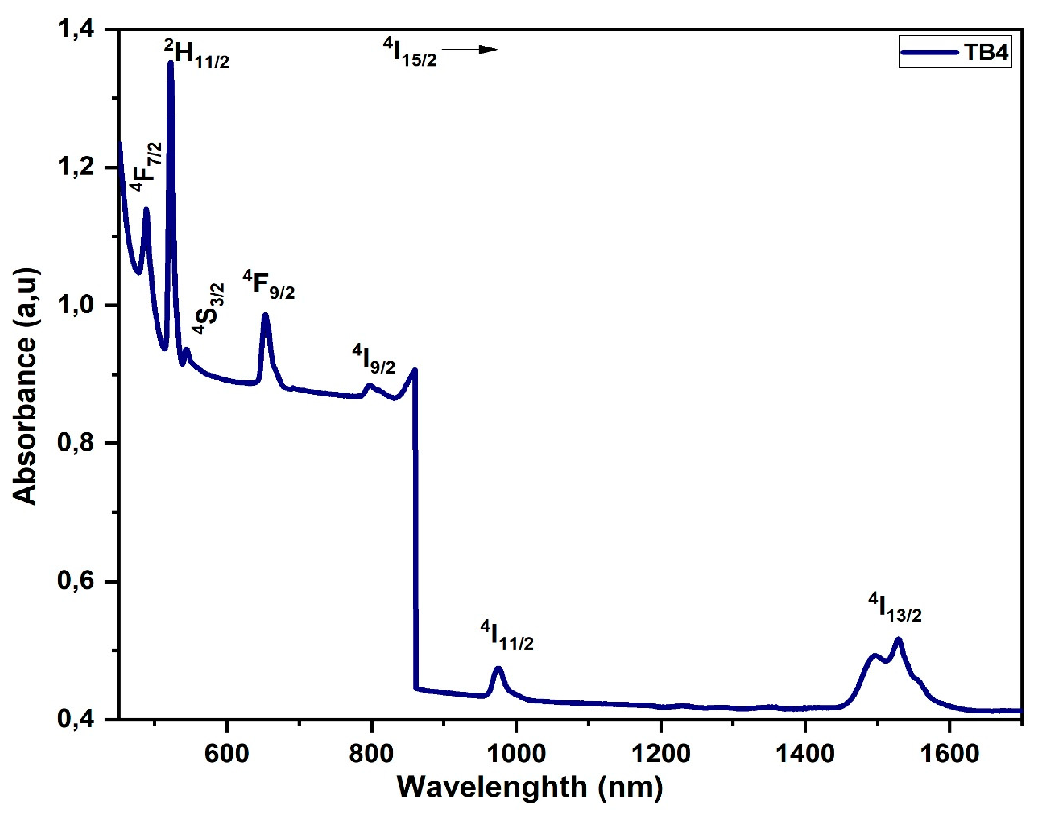
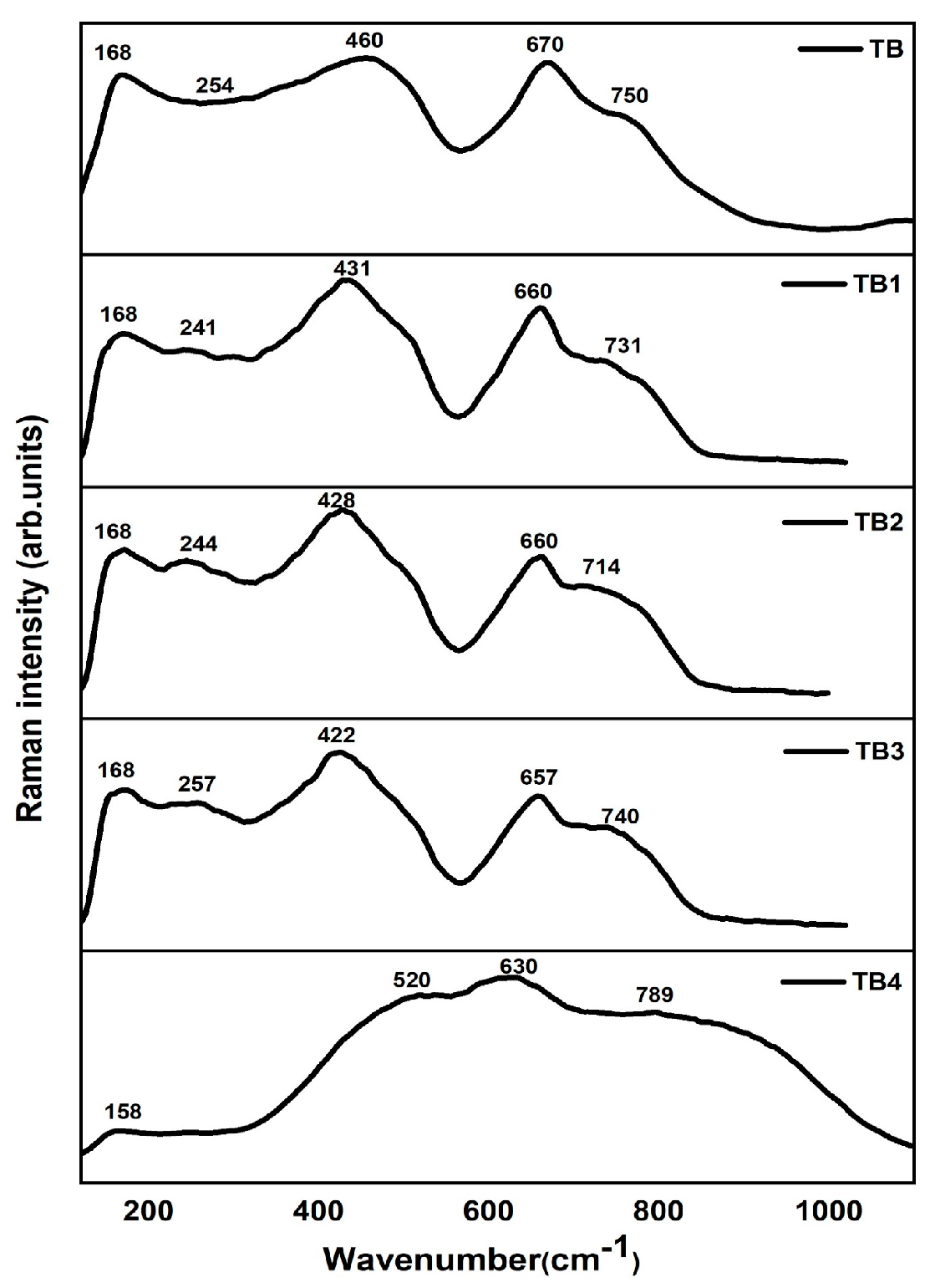
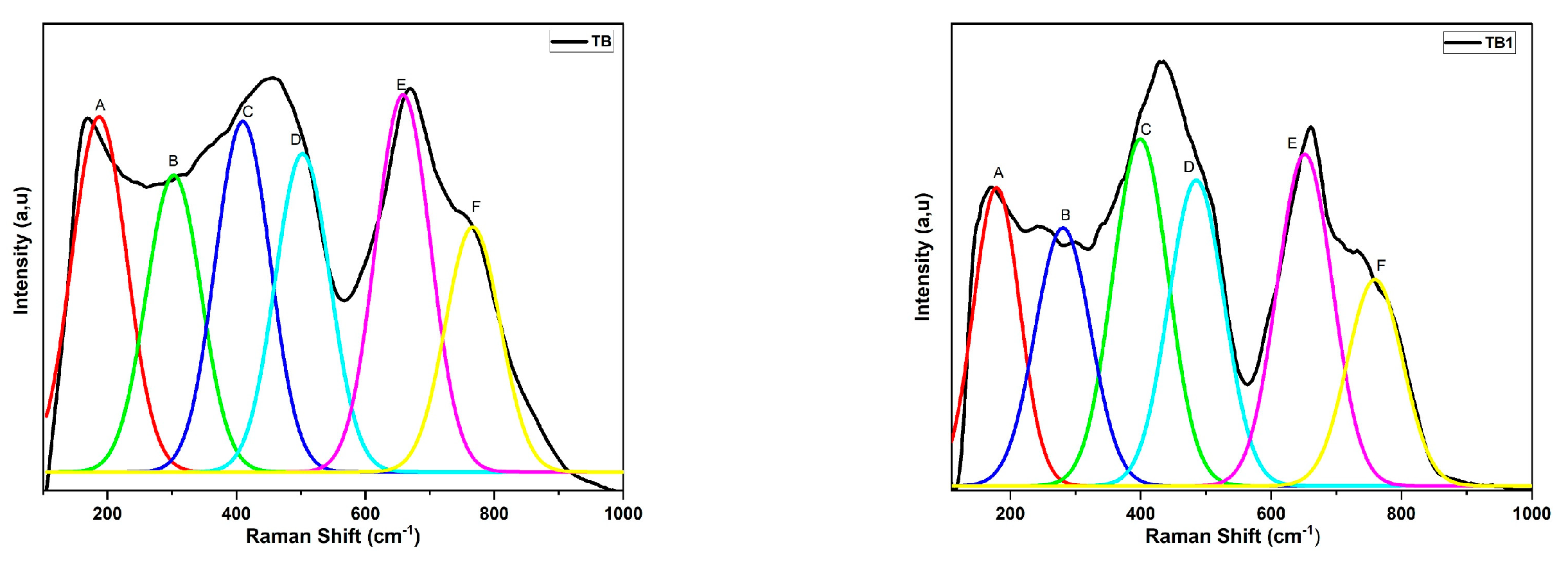
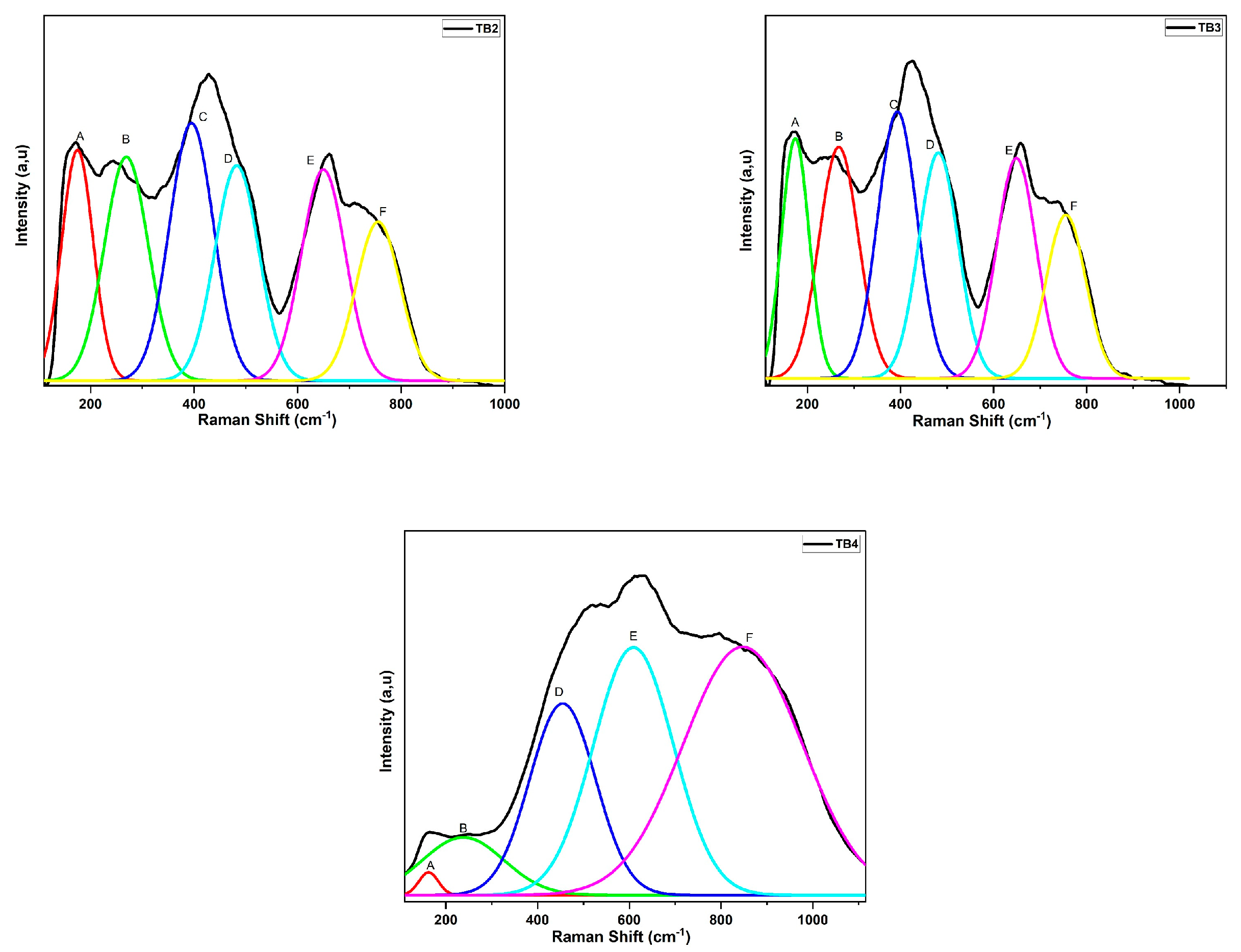
| Sample Codes | Composition |
|---|---|
| TB | 80 TeO2-20 BiCl3 |
| TB1 | 79.4 TeO2-20 BiCl3-0.6 Nd2O3 |
| TB2 | 79.4 TeO2-20 BiCl3-0.6 Sm2O3 |
| TB3 | 79.4 TeO2-20 BiCl3-0.6 Dy2O3 |
| TB4 | 79.4 TeO2-20 BiCl3-0.6 Er2O3 |
| Sample Code | Tg (±1 °C) | Tx1 (±1 °C) | Tp1 (±1 °C) | Tx2 (±1 °C) | ΔT (±1 °C) | H | S |
|---|---|---|---|---|---|---|---|
| TB | 296 | 412 | - | - | 116 | 0.39 | - |
| TB1 | 286 | 390 | 433 | 455 | 104/169 | 0.36/0.59 | 15.63/1.18 |
| TB2 | 285 | 394 | 455 | - | 109 | 0.38 | 23.32 |
| TB3 | 333 | 429 | 477 | - | 106 | 0.32 | 15.27 |
| TB4 | 286 | 413 | 430 | 435 | 127/149 | 0.44/0.52 | 7.54/10.41 |
| Sample Code | TB | TB1 | TB2 | TB3 | TB4 |
|---|---|---|---|---|---|
| Density ρg (g/cm3) | 5.506 | 5.475 | 5.468 | 5.482 | 5.488 |
| Mwt (g/mol) | 190.746 | 191.879 | 191.953 | 192.098 | 192.156 |
| Molar Volume Vmol (cm3/mol) | 34.65 | 35.05 | 35.10 | 35.04 | 35.01 |
| Oxygen Volume VOXG (cm3/mol) | 46.185 | 45.825 | 45.749 | 45.831 | 45.868 |
| OPD (g atom/l) | 21.65 | 21.83 | 21.87 | 21.83 | 21.81 |
| Refraction loss (RLoss) | 0.168 | 0.169 | 0.171 | 0.175 | 0.179 |
| Dielectric constant (ε) | 5.71 | 5.76 | 5.81 | 5.95 | 6.10 |
| Molar Refractivity Rmol (cm3/mol) | 21.171 | 21.499 | 21.614 | 21.823 | 22.044 |
| Molar Polarizability αmol (A°)3 | 8.401 | 8.531 | 8.576 | 8.601 | 8.748 |
| (eV) | 2.99 | 2.98 | 2.92 | 2.84 | 2.75 |
| Refractive index (n) | 2.39 | 2.40 | 2.41 | 2.44 | 2.47 |
| Polaron radius rpl (A°) | 0 | 8.60 | 8.61 | 8.60 | 8.60 |
| Inter ionic distance rin (A°) | 0 | 21.35 | 21.37 | 21.35 | 21.35 |
| Field strength Fs (×1014 cm−2) | 0 | 4.06 | 4.05 | 4.06 | 4.06 |
| RE ion concentration NRE (×1020 ions/cm3) | 0 | 1.031 | 1.029 | 1.031 | 1.032 |
4I9/2  | Λ (nm) | Oscillator Line Strength × 10−6 | |
|---|---|---|---|
| fexp | fcal | ||
| 4F3/2 | 876 | 3.56 | 3.72 |
| 4F5/2 + 2H9/2 | 802 | 10.92 | 10.50 |
| 4F7/2 + 4S 3/2 | 744 | 9.92 | 10.16 |
| 4F9/2 | 682 | 0.88 | 0.95 |
| 2H11/2 + 4G7/2 + 2G7/2 | 584 | 30.11 | 30.14 |
| 2K13/2 + 4G7/2 + 4G9/2 | 526 | 9.04 | 8.69 |
| 2K15/2 + 2G9/2 + 4G11/2 + 2D3/2 | 473 | 0.82 | 1.99 |
| 2P1/2 + 2D5/2 | 430 | 0.67 | 1.52 |
| Ω2 = 3.34 × 10−20 cm2, Ω4 = 3.86 × 10−20 cm2, Ω6 = 3.54 × 10−20 cm2 RMSE = 0.313 × 10−6 | |||
6H5/2  | Λ (nm) | Oscillator Line Strength × 10−6 | |
|---|---|---|---|
| fexp | fcal | ||
| 6H13/2 | 1970 | 0.35 | 0.32 |
| 6F ½ + 6HI15/2 | 1590 | 0.64 | 0.28 |
| 6F3/2 | 1488 | 0.70 | 1.20 |
| 6F5/2 | 1382 | 2.45 | 2.30 |
| 6F7/2 | 1234 | 4.80 | 4.65 |
| 6F9/2 | 1084 | 3.09 | 3.26 |
| 6F11/2 | 948 | 0.45 | 0.53 |
| Ω2 = 0.48 × 10−20 cm2, Ω4 = 2.04 × 10−20 cm2, Ω6 = 1.83 × 10−20 cm2 RMSE = 0.169 × 10−6 | |||
6H15/2  | Λ (nm) | Oscillator Line Strength × 10−6 | |
|---|---|---|---|
| fexp | fcal | ||
| 6H11/2 | 1687 | 1.69 | 2.24 |
| 6F11/2 + 6 H9/2 | 1279 | 9.28 | 9.24 |
| 6F9/2 + 6 H7/2 | 1097 | 3.58 | 3.75 |
| 6F7/2 + 6 H5/2 | 903 | 4.23 | 3.74 |
| 6F5/2 | 803 | 1.77 | 1.92 |
| 6F3/2 + 6F1/2 | 754 | 0.26 | 0.36 |
| Ω2 = 4.91 × 10−20 cm2, Ω4 = 0.63 × 10−20 cm2, Ω6 = 2.29 × 10−20 cm2 RMSE = 0.260 × 10−6 | |||
4I15/2  | Λ (nm) | Oscillator Line Strength × 10−6 | |
|---|---|---|---|
| fexp | fcal | ||
| 4I13/2 | 1529 | 2.63 | 3.10 |
| 4I11/2 | 974 | 0.74 | 1.45 |
| 4I 9/2 | 796 | 0.32 | 0.35 |
| 4F9/2 | 652 | 3.05 | 3.38 |
| 4S3/2 | 544 | 0.48 | 1.26 |
| 2H11/2 | 522 | 10.93 | 10.92 |
| 4F7/2 | 486 | 5.40 | 4.42 |
| Ω2 = 3.38 × 10−20 cm2, Ω4 = 0.72 × 10−20 cm2, Ω6 = 1.55 × 10−20 cm2 RMSE = 0.3866 × 10−6 | |||
| RE3+ | Glass Matrix | Ω2 | Ω4 | Ω6 | Ωλ Tendency | Reference |
|---|---|---|---|---|---|---|
| Nd3+ | TB1 | 3.34 | 3.86 | 3.54 | Ω2 > Ω6 > Ω4 | Present Work |
| TLF | 5.61 | 4.17 | 5.44 | Ω2 > Ω6 > Ω4 | [25] | |
| TBZBNd0.5 | 2.89 | 1.35 | 1.59 | Ω2 > Ω6 > Ω4 | [26] | |
| TW-1 Nd | 4.60 | 3.30 | 3.50 | Ω2 > Ω6 > Ω4 | [27] | |
| ZNNd0.5 | 3.76 | 1.16 | 3.23 | Ω2 > Ω6 > Ω4 | [28] | |
| Sm3+ | TB2 | 0.40 | 2.16 | 1.19 | Ω4 > Ω6 > Ω2 | Present Work |
| LBZnFSm | 0.4117 | 9.46 | 8.92 | Ω4 > Ω6 > Ω2 | [29] | |
| PKAMZFSm | 0.41 | 2.99 | 2.67 | Ω4 > Ω6 > Ω2 | [30] | |
| BLNS | 3.92 | 8.17 | 5.82 | Ω4 > Ω6 > Ω2 | [31] | |
| LBTAF | 0.27 | 2.52 | 2.47 | Ω4 > Ω6 > Ω2 | [32] | |
| Dy3+ | TB3 | 4.91 | 0.63 | 2.29 | Ω2 > Ω6 > Ω4 | Present Work |
| SFBiBDy1 | 39.52 | 6.42 | 9.15 | Ω2 > Ω6 > Ω4 | [33] | |
| Lead borate | 4.90 | 0.94 | 2.07 | Ω2 > Ω6 > Ω4 | [34] | |
| TPA | 6.45 | 1.27 | 2.90 | Ω2 > Ω6 > Ω4 | [8] | |
| BSLNAD3 | 1.29 | 0.35 | 0.42 | Ω2 > Ω6 > Ω4 | [35] | |
| Er3+ | TB4 | 3.38 | 0.72 | 1.55 | Ω2 > Ω6 > Ω4 | Present Work |
| 0.5ErBT | 5.73 | 2.01 | 2.37 | Ω2 > Ω6 > Ω4 | [36] | |
| BTNMES | 3.53 | 1.18 | 2.06 | Ω2 > Ω6 > Ω4 | [37] | |
| TZNBG2 | 5.02 | 0.95 | 1.21 | Ω2 > Ω6 > Ω4 | [38] | |
| TPBKZFEr05 | 7.23 | 1.02 | 1.46 | Ω2 > Ω6 > Ω4 | [39] |
| Sample Code | Peak Position in cm−1 | |||||
|---|---|---|---|---|---|---|
| A | B | C | D | E | F | |
| TB | 188 | 303 | 411 | 503 | 658 | 767 |
| TB1 | 181 | 280 | 398 | 485 | 653 | 761 |
| TB2 | 175 | 270 | 394 | 482 | 648 | 757 |
| TB3 | 175 | 266 | 395 | 481 | 650 | 758 |
| TB4 | 163 | 237 | Not appeared | 453 | 609 | 854 |
| Band Position | Peak | Assignments |
|---|---|---|
| 163–188 cm−1 | A | Heavy metal bonds. |
| 237–303 cm−1 | B | Bending vibrations of Bi–O–Bi or O–Bi–O linkages of BiO6. |
| 394–411 cm−1 | C | Bending vibrations of O-Te-O bonds in TeO4 units. |
| 453–503 cm−1 | D | Symmetric stretching vibrations of the continuous network composed of TeO4 tbp. |
| 609–658 cm−1 | E | Antisymmetric stretching vibrations of Te-O-Te bridge bonds occurring in TeO4 tbp units and BiO6 or BiCl6 octahedral units. |
| 757–854 cm−1 | F | Stretching vibration of TeO3 units. Stretching vibrations of bonds between Te and non-bridged oxygen atoms occurring in TeO3+1 units. |
Disclaimer/Publisher’s Note: The statements, opinions and data contained in all publications are solely those of the individual author(s) and contributor(s) and not of MDPI and/or the editor(s). MDPI and/or the editor(s) disclaim responsibility for any injury to people or property resulting from any ideas, methods, instructions or products referred to in the content. |
© 2023 by the authors. Licensee MDPI, Basel, Switzerland. This article is an open access article distributed under the terms and conditions of the Creative Commons Attribution (CC BY) license (https://creativecommons.org/licenses/by/4.0/).
Share and Cite
Boudchicha, N.; Iezid, M.; Goumeidane, F.; Legouera, M.; Prasad, P.S.; Rao, P.V. Judd–Ofelt Analysis and Spectroscopy Study of Tellurite Glasses Doped with Rare-Earth (Nd3+, Sm3+, Dy3+, and Er3+). Materials 2023, 16, 6832. https://doi.org/10.3390/ma16216832
Boudchicha N, Iezid M, Goumeidane F, Legouera M, Prasad PS, Rao PV. Judd–Ofelt Analysis and Spectroscopy Study of Tellurite Glasses Doped with Rare-Earth (Nd3+, Sm3+, Dy3+, and Er3+). Materials. 2023; 16(21):6832. https://doi.org/10.3390/ma16216832
Chicago/Turabian StyleBoudchicha, Naziha, Mostepha Iezid, Faycal Goumeidane, Messaoud Legouera, P. Syam Prasad, and P. Venkateswara Rao. 2023. "Judd–Ofelt Analysis and Spectroscopy Study of Tellurite Glasses Doped with Rare-Earth (Nd3+, Sm3+, Dy3+, and Er3+)" Materials 16, no. 21: 6832. https://doi.org/10.3390/ma16216832
APA StyleBoudchicha, N., Iezid, M., Goumeidane, F., Legouera, M., Prasad, P. S., & Rao, P. V. (2023). Judd–Ofelt Analysis and Spectroscopy Study of Tellurite Glasses Doped with Rare-Earth (Nd3+, Sm3+, Dy3+, and Er3+). Materials, 16(21), 6832. https://doi.org/10.3390/ma16216832









